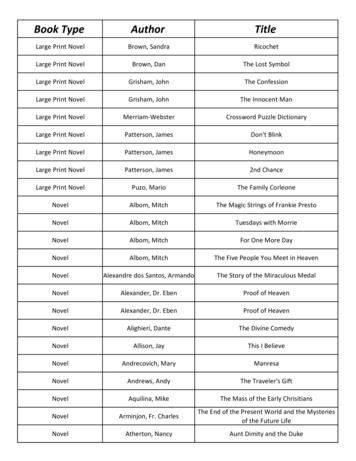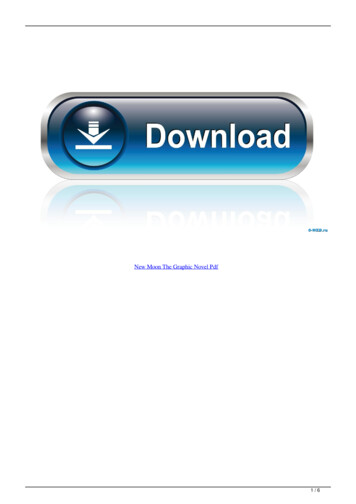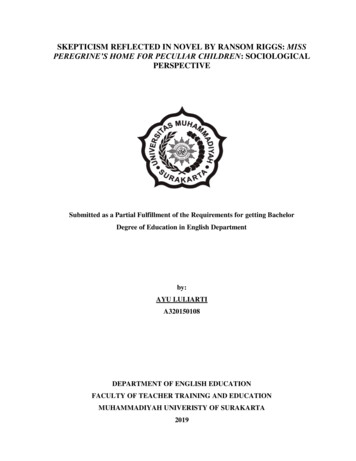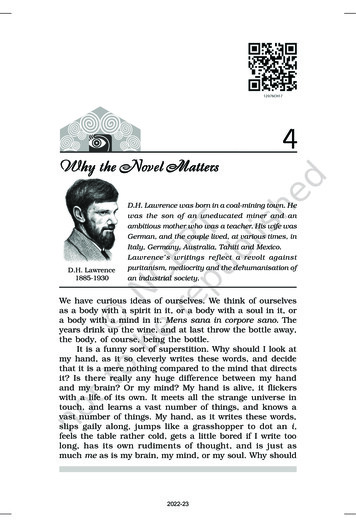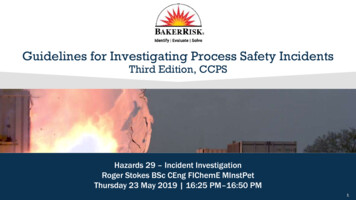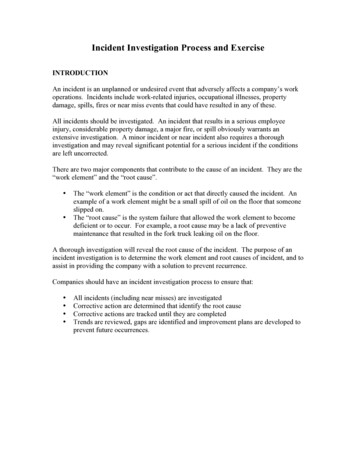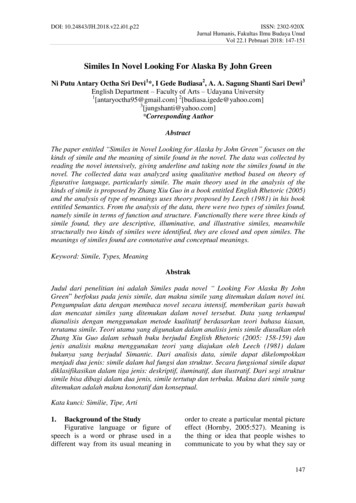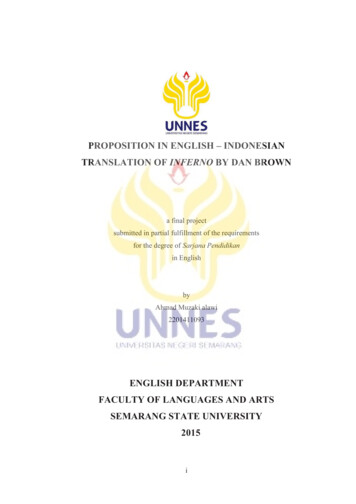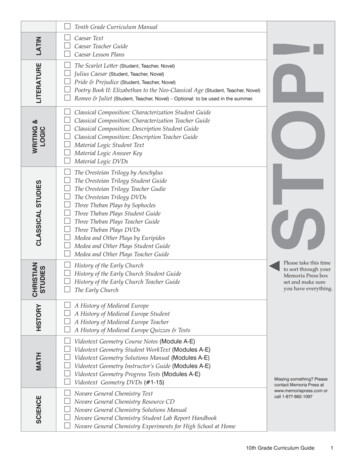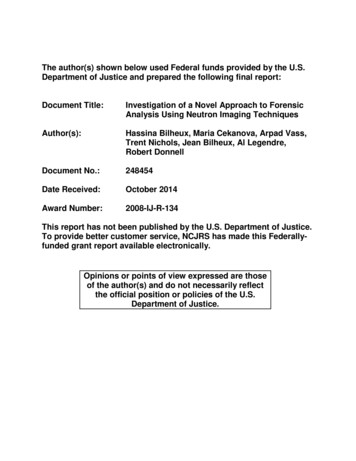
Transcription
The author(s) shown below used Federal funds provided by the U.S.Department of Justice and prepared the following final report:Document Title:Investigation of a Novel Approach to ForensicAnalysis Using Neutron Imaging TechniquesAuthor(s):Hassina Bilheux, Maria Cekanova, Arpad Vass,Trent Nichols, Jean Bilheux, Al Legendre,Robert DonnellDocument No.:248454Date Received:October 2014Award Number:2008-IJ-R-134This report has not been published by the U.S. Department of Justice.To provide better customer service, NCJRS has made this Federallyfunded grant report available electronically.Opinions or points of view expressed are thoseof the author(s) and do not necessarily reflectthe official position or policies of the U.S.Department of Justice.
Final Technical ReportReport Title: Investigation of a novel approach to forensic analysis using neutron imagingtechniquesAward Number: 2010-93071-TN-DNAuthor(s): Hassina Bilheux1, Maria Cekanova2, Arpad Vass1, Trent Nichols1, Jean Bilheux1(*), Al Legendre2, and Robert Donnell212Oak Ridge National Laboratory, Oak Ridge, TN 31831University of Tennessee, Knoxville, TN 37996(*) In-kind contributionAbstractThis proof-of-principle research focused on establishing the novel use of neutron radiography forforensic research and, more precisely, for the determination of post-mortem interval (PMI) bythe measurement of changes in neutron attenuation in decaying canine skeletal muscle. Thisresearch answered two questions: (1) how to select the optimal tissues and how those tissues arebest prepared for neutron radiography and (2) what is the effectiveness of using neutrons tomeasure changes in the decaying tissues as a function of time. Controlled (i.e. laboratory settingsat the Oak Ridge National Laboratory) and uncontrolled (i.e. Anthropology Research Facility atthe University of Tennessee, Knoxville) conditions were used to study the effects of differentenvironmental conditions (mainly temperature and humidity) on the neutron transmissionthrough the tissue samples. The primary hypothesis of this study is that by measuring the changein the hydrogen (H) content determined by neutron transmission, the state of canine skeletalmuscle degradation can be predicted. Results demonstrated that the increase in neutrontransmission that corresponded to a decrease in hydrogen content in the tissue was correlatedwith the time of decay of the tissue. Tissues depleted in hydrogen are brighter in the neutrontransmission radiographs of skeletal muscles, lung, and bone, under controlled conditions. Over aperiod of 10 days, changes in neutron transmission through lung and muscle were found to behigher than bone by 8.3%, 7.0 %, and 2.0 %, respectively. In conclusion, neutron radiographycan be used for detection of hydrogen changes in decaying tissues that are correlated with thepost-mortem interval.DisclaimerCanine cadavers were obtained from the Tennessee (TN) Animal Control Agency afterhumane euthanasia due to the inability of the shelter to secure adequate long-term care oradoption. No animals were euthanized for this study.1This document is a research report submitted to the U.S. Department of Justice. This report has notbeen published by the Department. Opinions or points of view expressed are those of the author(s)and do not necessarily reflect the official position or policies of the U.S. Department of Justice.
Table of tive SummaryI.Introduction1. Statement of the problem2. Literature citations and review3. Statement of hypothesis or rationale for the researchII.Methods1. Experimental design2. Neutron imaging facility3. Neutron radiography, data processing and analysisIII.Results1. External examination of decomposed canine cadaversduring winter 2011 and summer 2012in East Tennessee (uncontrolled conditions)2. Neutron radiography of canine tissues under controlledEnvironment3. Neutron radiography of canine skeletal tissues under uncontrolledConditions (winter 2011 and summer 2012 in East Tennessee)IV.Conclusion1. Discussion of findings2. Implication for policy and practice3. Implications for further researchV.AcknowledgmentsVI.ReferencesVII. Dissemination of research findings11134445556782This document is a research report submitted to the U.S. Department of Justice. This report has notbeen published by the Department. Opinions or points of view expressed are those of the author(s)and do not necessarily reflect the official position or policies of the U.S. Department of Justice.88101213131313141415
Executive Summary (2500-4000 words max)One of the most difficult challenges in forensic research for criminal justice investigations isto determine objectively the post-mortem interval (PMI). The determination of PMI is often acritical piece of information at the crime scene. Most PMI techniques rely on gross observationalchanges of cadavers that are subjective and highly sensitive to environmental variables that candrastically alter the estimated PMI. Chemical analysis of volatile fatty acids (VFA) based onchemical elements rather than physical changes, can be used to create a more accurate timelineof decomposition. The further development of an objective method to estimate PMI cansignificantly impact forensic science and meet Daubert standards.After death, tissue undergoes sequential organic and inorganic changes, as well as a gradualreduction of water content. Living organisms consist mainly of the six basic elements: carbon,hydrogen, oxygen, nitrogen, phosphorus, and sulfur. These elements combine to form the fourmajor classes of biological macromolecules found in living matter: proteins, nucleic acids,polysaccharides, and lipids. While carbon dominates the chemistry of biological tissues,hydrogen atoms are the most abundant element. Neutron imaging is based on the attenuation dueto both scattering and absorption of a directional neutron beam by the matter through which itpasses. Neutron imaging is complementary, rather than competitive with X-ray imaging. SinceX-rays are scattered and absorbed by the electrons, the attenuation increases monotonically withatomic number. Neutrons interact with atomic nuclei in a complex manner so that neutronattenuation does not scale in a regular way with atomic number. Hydrogen nuclei scatter thermaland cold neutrons more strongly than any other atomic nucleus. Thus, unlike other imagingmethods such as X-rays, neutrons are strongly attenuated by hydrogen, which is the predominantelemental constituent of biological materials and the attenuation manifests as contrast in animage. These contrast differences in neutron imaging can readily be applied in a forensic contextto determine small changes in hydrogen amount. Since body decomposition starts just minutesafter death, hydrogen concentration changes over time as well. This may create a timeline of acadavers’ decomposition.The purpose of this research is to assess the capability of neutron radiography to detecthydrogen changes in decaying tissues and whether this innovative approach can be a useful andobjective tool for estimating post-mortem interval. This report focuses on two sets ofexperiments performed on medium size dog cadavers with no apparent diseases. Several caninetissues were collected, fixed and imaged using neutrons. Neutron radiography of fixed tissueswas compared to neutron radiographs of fresh tissues.The first phase of this research was to optimize the choice of tissue samples, the method ofextraction and preparation of the tissue samples that was compatible with neutron imaging.Several samples were measured including lung, heart, liver, skeletal muscle, kidney, skin, andbone. Three fixation techniques were employed: formalin, ethanol, and deuterated ethanol.Although deuterated ethanol fixation did not affect neutron transmission (no hydrogen was addedto the tissue during fixation and deuterium has a low neutron cross-section and thus does notcontribute to neutron transmission in a significant way), after 16 hours the tissues shrank by50%. Ethanol and formalin fixation did alter neutron transmission and formalin had lessshrinkage (only 4% after 16 hrs). Thus, formalin was selected as the optimum fixation for thisforensic research.Two sets of environmental conditions were used to measure the neutron transmissionchanges through time: controlled (laboratory setting) and uncontrolled (at the University ofTennessee Anthropology Research Facility). The team focused on skeletal muscles primarily, asthese tissues can be removed using biopsy needles. Lung and bone were also studied incontrolled environmental conditions as fast and slow decaying tissues, respectively.The choice of tissue (lung, muscle, or bone) directly affected the rate of change in neutrontransmission due the changes in H content in the decaying tissue. Depending on environmental3This document is a research report submitted to the U.S. Department of Justice. This report has notbeen published by the Department. Opinions or points of view expressed are those of the author(s)and do not necessarily reflect the official position or policies of the U.S. Department of Justice.
conditions, skeletal muscle will decay in a few days but this can extend to a few weeks, asobserved at the UTARF during winter 2011. Finally, bones outlast all “soft” tissues. Thesedifferent putrefaction rates may be an advantage for this technique. Depending on the stage ofdecomposition at the crime scene, one could select a short-lasting sample, such as lung and/ormuscle, or a long-lasting sample, such as a bone.Fixation of the tissue offers the option to “freeze” the sample in time, i.e. no furtherdecomposition occurs, and transport it to a location where neutron imaging can be performed. Asdetermined by this research, fixation does not alter the information but creates an offset in thetransmission value that can be accounted for during data processing and analysis. Thus, tissuescan easily be fixed in the field by taking the samples and placing them into a container full offormalin. After that time, the sample will not change for a very long time as far as neutronradiography is concerned. This is then a convenient, simple, cheap, and easy method to obtain atissue sample that can be used to accurately determine the PMI.While controlled conditions data provide linear response in neutron transmission, theuncontrolled measurements do not show the same linear increase as a function of time. The dataare highly affected by environmental conditions. The choice of summer measurements at theUTARF seems a less than optimum time to collect muscle tissue samples to understand thescience due to excessive insect activity. Dealing with such situations can be better addressedwhen the correlations have been modeled. In conclusion, the neutron radiography can be used fordetection of hydrogen changes that can provide an objective determination of PMI.I. Introduction1. Statement of the problemOne of the most difficult challenges in forensic research for criminal justice investigations isto objectively determine the post-mortem interval (PMI). The determination of PMI is often acritical piece of information at the crime scene and subsequently at a trial. Most PMI techniquesrely on gross observational changes of cadavers that are subjective and highly sensitive toenvironmental variables. Chemical analyses of volatile fatty acids (VFA) that have proven usefulindicate that chemical elements rather than physical changes can create a better timeline ofdecomposition. The development of an objective method to estimate PMI would significantlyimpact forensic science and meet Daubert standards.2. Literature citations and reviewThe Process of Decomposition - Human decomposition begins a few minutes after death.Decomposition is governed initially by a process called autolysis – or self-digestion. As cells ofthe body are deprived of oxygen, carbon dioxide increases, pH decreases, and metabolitesaccumulate, which further degrade normal cellular function. Concomitantly, cellular enzymes(lipases, proteases, etc.) begin to digest the cells from the inside out which eventually causesthem to rupture and release nutrient-rich fluids. [1] Autolysis usually does not become visuallyapparent for a few days. It is first observed by the appearance of fluid filled blisters on the skinand skin slippage where large sheets of skin slough off the body. After enough cells haveruptured their contents of nutrient-rich fluids, the process of putrefaction begins.Putrefaction is the destruction of the soft tissues of the body by the action of microorganisms(bacteria, fungi and protozoa which are present in and on the body naturally) and results in thecatabolism of tissue into gases, liquids and simple molecules. Usually, the first visible sign ofputrefaction is a greenish discoloration of the skin due to the formation of sulfhemoglobin insettled blood. This process progresses into distension of tissues due to the formation of variousgases (hydrogen sulfide, carbon dioxide, methane, ammonia, sulfur dioxide, and hydrogen) that4This document is a research report submitted to the U.S. Department of Justice. This report has notbeen published by the Department. Opinions or points of view expressed are those of the author(s)and do not necessarily reflect the official position or policies of the U.S. Department of Justice.
is especially prominent in the bowels. Putrefaction is associated with anaerobic fermentation,primarily in the gut, releasing by-products rich in volatile fatty acids (primarily butyric andpropionic acids). Shortly after the purging of gases due to putrefaction, active decay begins [1,2].Muscles are composed of mostly proteins, which in general break down into amino acids byproteolysis and further bacterial decomposition yield to hydrogen sulphide gas, pyruvic acid,thiols, and ammonia. In addition to protein, muscle contains fat that is degraded into fatty acidsand glycerol by lipases. Further free fatty acids are degraded in anaerobic conditions throughhydrogenation by bacterial enzyme (hydrogen content is increased by transforming unsaturatedbonds into single bonds) or in aerobic environmental condition by oxidation to produce peroxidelinkages in fatty acids, eventually producing aldehydes and ketones. The different conditions ofdecomposition will affect the amount of measured hydrogen content.The Post-mortem Interval - Post-mortem interval techniques can be estimated on cellularphone records, receipts, etc., which may not always be available as they strongly depend on theeconomical status and life style of the victim. There are currently few scientific methods basedon chemical measurements that can be used to estimate the PMI. Typically, such information isgained through the cooperation of trained forensic scientists who provide information based onexperience and opinion. For example, estimating the PMI prior to the onset of putrefaction (3672 hrs) generally involves visual inspection of the body by observing the appearance (i.e. rigorand livor mortis), determining the core body temperature, and examining the gastric contents [3,4]. During this time period, changes in blood and cerebrospinal fluid biochemistry are oftendetermined but these measurements are subject to considerable error and are often unreliable fordetermining the PMI, as is measuring the vitreous humour potassium concentration [4]. To date,volatile fatty acids have been the only reliable biomarkers of PMI for preskeletonized remainsduring putrefaction [5]. The decay rate of DNA in ribs has also been investigated, but has yet tobe field-tested [6]. The reported accuracy of the fatty acid determination method for PMI of preskeletonized remains is 2 days/month. Once a corpse is skeletonized, the concentrations ofinorganic elements (K , Ca2 , Mg2 , etc.) that migrate into the surrounding soil have been usedfor determining PMI [5]. The reported accuracy of this method for PMI of skeletonized remainsover a year old is 2 weeks. Forensic entomology is another useful tool that has, in the lastseveral years, gained success in determining PMI [7-10] and, along with decomposition byproducts, is currently one of the best means of determining the PMI. While these methods coverthe entire breadth of human decomposition, from early ( 12 hours) to very late (skeletonized 10years), PMIs are still highly problematic due to their large error ranges.3. Statement of hypothesis or rationale for the researchThe purpose of this research was to assess the capability of neutron radiography to detecthydrogen (H) changes in decaying tissues and whether this innovative approach can be a usefuland objective tool for estimating PMI.The hypothesis was that neutron transmission through decaying tissues increases with timedue to the decrease of H content in the tissues. Furthermore, the change in hydrogen contentwould be related to the PMI by some function of time. It was also predicted that environmentalconditions would change the rate of hydrogen decrease in the tissues.II.Methods1. Experimental designA prior report was submitted to the National Institute of Justice (NIJ) (submission date:January 31, 2011) and was focused on the project’s first task: the optimization of choice and5This document is a research report submitted to the U.S. Department of Justice. This report has notbeen published by the Department. Opinions or points of view expressed are those of the author(s)and do not necessarily reflect the official position or policies of the U.S. Department of Justice.
preparation of the tissue samples prior to neutron radiography. The report determined the optimalpreparation by comparing fixed and fresh tissues and by examining the effect of the thickness ofdifferent canine tissues.This report focuses on two sets of experiments performed on medium size dog cadavers withno apparent diseases. Several canine tissues were collected, fixed and imaged using neutronimaging. The fixed tissues were compared to their equivalent fresh ones. The selection of thecarcasses was independent of the sex, breed and estimated age of the dogs.Controlled environmental conditions: Skeletal muscle samples of 2 cm x 2 cm x 2 mm sizewere dissected from canine cadavers, wrapped in aluminum (Al) foil, and stored in a 4 ºCrefrigerator at the University of Tennessee College of Veterinary Medicine (UTCVM) beforebeing transported on ice to the Oak Ridge National Laboratory (ORNL) High Flux IsotopeReactor (HFIR) for neutron radiography. Bones and lung tissues were also extracted for neutronradiography assessment. Tissues were kept under constant conditions (22 ºC /- 2 ºC and 5060% humidity) at the neutron facility and were exposed for a few minutes to neutrons at regulartime intervals over several days.Uncontrolled environmental conditions: In collaboration with the University of TennesseeAnthropology Research Facility (UTARF), canine cadavers were positioned on the ground, inthe shade of a tree and with a protective net to minimize scavenger activities during winter 2011and summer 2012. Temperature and humidity information in Knoxville, TN was obtained fromthe Biosystems Engineering Department of the Institute of Agriculture at the University ofTennessee [11]. One cadaver was placed at the UTARF on the first day of the neutronradiography measurements for the winter uncontrolled environmental conditions studies (Day 0or December 7, 2011). During the summer experiments, four dog cadavers were brought to theUTARF at six, four, and two weeks prior to the neutron measurements. The fourth cadaver wasplaced at the facility on the first day (Day 0 or June 18 2012) of the experimental neutronmeasurements. Photographs of the dog cadavers at the UTARF were collected to monitor decaychanges. Three samples of decaying skeletal muscle tissues were extracted at each samplinginterval using bone biopsy needles to obtain 2 and 5 mm thick samples. The use of biopsyneedles was driven by the need to extract similar samples and reduce the risk of human error intissue preparation. An example of tissue preparation is illustrated in Figure 1A (tissue removedusing the biopsy needle) and Figure 1B (tissue ready to be wrapped in Aluminum foil). Arepresentative gray scale and color neutron radiographs are illustrated in Figures 1D and 1E,respectively. The other two samples were fixed in formalin (24-hr fixation) for histologicalanalysis and neutron radiography the next day, respectively. After extraction, the incision wascovered with duct tape, and a new incision was used each time of sampling. New incisions weremade along the anterior thigh until sampling could no longer continue due to either the absenceof muscle tissue or excessive maggot activity during summer.2. Neutron imaging facilityThe ORNL Neutron Sciences Directorate has a beamline (CG-1D) at the High Flux IsotopeReactor (HFIR) that is used for neutron imaging. A pinhole-geometry aperture system is used atthe entrance of a He-filled flight path to allow L/D variation from 400 to 800 (L is the distancebetween the aperture and the detector image, and D is the diameter of the aperture). An increasein L/D can increase spatial resolution at the cost of neutron intensity. Samples sit on atranslation/rotation stage for alignment and tomography purposes. Detectors for the CG-1Dbeamline are (1) an ANDOR DW936 charge coupled device (CCD) camera with a field of viewof approximately 7 cm x 7 cm with 50 μm spatial resolution and 1 frame per second timeresolution (with binning) and (2) a Micro-Channel Plate (MCP) detector with a 4 cm radius field6This document is a research report submitted to the U.S. Department of Justice. This report has notbeen published by the Department. Opinions or points of view expressed are those of the author(s)and do not necessarily reflect the official position or policies of the U.S. Department of Justice.
of view and a 40 μm spatial resolution. 6LiF/ZnS scintillators of thickness varying from 50 to200 μm are being used at this facility. The white beam flux at CG-1D is approximately 1 x 107neutrons/cm2/s for an L/D of 460. A schematic and a photograph of the facility are shown inFig.1C.Neutron imaging is based on the transmission of neutrons through an object. Neutrontransmission is governed by the neutron interactions, scattering and absorption, with matter.Beer-Lambert law states that the transmission, I, of a homogeneous sample is defined as:𝐼 𝐼0 𝑒 𝜇𝑥(1)where I0 is the intensity of the incident beam, µ is the attenuation coefficient, and x is thethickness of the sample. The attenuation coefficient can be calculated from neutron crosssections.3. Neutron radiography, data processing and analysisSamples were positioned on a translation stage between the neutron beam flight tube and thecharge coupled device (CCD) camera as shown in Figure 1C. Tissues wrapped in Al were exposedto the neutron beam for approximately 2 minutes. For these measurements, a spatial resolution of50 µm was achieved. Three images of the same tissue were collected each time. Under controlledconditions (22 ºC /- 2 ºC and 50-60% humidity), the tissues were kept wrapped in aluminum(Al) and left to decay at the neutron facility. They were measured at regular intervals over 10 days.Samples from uncontrolled conditions were measured 1 hr after extraction at the UTARF.Transmission values were obtained from the neutron radiographs using MATLAB [12] afterimage normalization. Images were normalized using Equation (1), where Imagenormalizedcorresponds to the normalized image, Imageraw is the raw image of the tissue, Imagedark field is theelectronic noise of the CCD, Imageopen beam is the image of the beam (without the tissue sample)and fcor is the correction factor for beam fluctuation. A 4 x 4 median filter was also applied toremove the CCD hot/cold pixels and gammas strikes on the CCD chip.𝐼𝑚𝑎𝑔𝑒𝑟𝑎𝑤 𝐼𝑚𝑎𝑔𝑒𝑑𝑎𝑟𝑘 ��𝑚𝑎𝑙𝑖𝑧𝑒𝑑 𝐼𝑚𝑎𝑔𝑒𝑜𝑝𝑒𝑛 𝑏𝑒𝑎𝑚 𝐼𝑚𝑎𝑔𝑒𝑑𝑎𝑟𝑘 𝑓𝑖𝑒𝑙𝑑 𝑓𝑐𝑜𝑟 (2)An example of a gray scale and color enhanced neutron radiograph of a skeletal muscle is shownin Figures 1D and 1E, respectively. Neutron attenuation was estimated from five regions of interestthat were away from the edge of the tissue for the 2 cm x 2 cm x 2 mm tissues (controlled conditionsprotocol). This approach was chosen to minimize the statistical variation between tissues.Moreover, segmentation of the tissue was used for the 2 and 5 mm diameter samples extractedusing a biopsy needle (uncontrolled conditions protocol) such that neutron attenuation wasestimated using the whole sample. Standard deviation was used to calculate statistical errors.7This document is a research report submitted to the U.S. Department of Justice. This report has notbeen published by the Department. Opinions or points of view expressed are those of the author(s)and do not necessarily reflect the official position or policies of the U.S. Department of Justice.
Figure 1: Sample collection for neutron radiography measurements. (A) 2- and 5-mm thick samples ofdecaying skeletal muscle tissues were extracted at different times using an 8-gauge bone biopsy needles.(B) Tissue samples were wrapped in aluminum foil and measured 45 min after extraction. (C) Sampleswere positioned on a translation stage between the neutron beam flight tube and the CCD camera at theORNL neutron imaging facility. Tissues were exposed to the neutron beam for 2 minutes and radiographswere collected by a 2048 x 2048 CCD camera at a spatial resolution of approximately 50 µm. (D) Grayscale neutron radiograph and (E) color enhanced neutron radiograph of the skeletal muscle.III.Results1. External examination of decomposed canine cadavers during winter 2011 andsummer 2012 in East Tennessee (uncontrolled conditions)In order to visually assess the level of decay, a series of photographs were taken at the UTARFduring winter 2011 and summer 2012. During the winter, the decomposition of the canine cadaverwas not externally visible due to cold weather conditions (see Table 1; Day 0 corresponds to theday the cadaver was placed at the UTARF) and absence of insect and scavenger activities over the10 days of the study. The average values of recorded environmental data over the duration of thestudy were relative low, i.e. average rain fall of 0.9 mm, 72.8 % humidity, air and soil temperaturesof 6.4 ºC and 10 ºC, respectively.During the summer experiments, four dog cadavers were brought to the UTARF six (Day -41or May 8 2012), four (Day -25 or May 24 2012), and two (Day -14 or June 4 2012) weeks prior tothe neutron measurements. In addition, a "fresh" cadaver was placed at the facility on the first day(Day 0 or June 18 2012) of the experimental neutron measurements. Due to high average air andsoil temperatures, i.e. 22.4 ºC and 25.5 ºC, respectively (Table 2) and high insect activities, thedecomposition of the cadavers that were left two and four weeks was advanced as compared to thefreshly placed cadaver on Day 0. The cadaver placed six weeks prior to external examinations hadreached a full-skeletonized stage.8This document is a research report submitted to the U.S. Department of Justice. This report has notbeen published by the Department. Opinions or points of view expressed are those of the author(s)and do not necessarily reflect the official position or policies of the U.S. Department of Justice.
Table 1. Recorded environmental conditions close to the burial site during winter 2011 [11]. Datacomprise solar energy per surface area, rainfalls, humidity, air and soil temperatures, and high andlow air temperatures.Winter 2011DayDay 0Day 1Day 2Day 3Day 4Day 5Day 6Day 7Day 8Average 11.2613.17Soil Temp,15 cm 718.52Air 27.010.9472.836.389.9812.431.92Table 2. Recorded environmental conditions close to the burial site during winter 2011 [12]. Datacomprise solar energy per surface area, rainfalls, humidity, air and soil temperatures, and high andlow air temperatures.Summer Soil Temp,15 cm depth(ºC)Air HighTemp(ºC)Air LowTemp(ºC)Day -1027.960.0051.0022.2325.5729.4815.41Day -922.510.0060.8223.4325.5930.4616.47Day -813.220.3171.3022.7726.2927.8120.05Day -713.313.4478.1022.8525.2728.2819.72Day -616.732.5175.6024.3225.6529.1520.72Day -523.620.0060.3924.6426.0331.2717.99Day -422.100.0061.6724.2326.2233.3318.33Day -323.350.0064.0424.8926.7232.3318.86Day -218.363.1367.8324.1127.1829.2220.12Day -121.330.0064.4824.3726.4330.7319.72Day 027.100.0058.1925.8327.1532.6618.73Day 125.520.0058.7626.0127.5934.2518.66Day 224.870.0057.0027.3528.5734.1920.65Day 323.772.8261.0927.3929.3734.9221.12Day 4Average 1365.6122.4425.5229.3116.959This document is a research report submitted to the U.S. Department of Justice. This report has notbeen published by the Department. Opinions or points of view expressed are those of the author(s)and do not necessarily reflect the official position or policies of the U.S. Department of Justice.
2. Neutron radiography of canine tissues under controlled environmentThree representative sections of 2 cm x 2 cm x 2 mm canine tissues (lung, skeletal muscle, andbone) were imaged at the ORNL High Flux Isotope Reactor (HFIR) using neutron radiography.The tissues were kept under controlled decay environment and the neutron radiography wasperformed daily over 10 days. Neutron transmission through the respective tissues was plotted asa function of time as shown in Figures 2 (lung), 3 (muscle) and 4 (bone). The transmissionincreased over time (16h). Over a period o
Report Title: Investigation of a novel approach to forensic analysis using neutron imaging techniques . Award Number: 2010-93071-TN-DN . Author(s): Hassina Bilheux1, Maria Cekanova2, Arpad Vass1, Trent Nichols1, Jean Bilheux1 (*), Al Legendre2, and Robert Donnell2. 1 Oak Ridge National Laboratory, Oak Ridge, TN 31831
